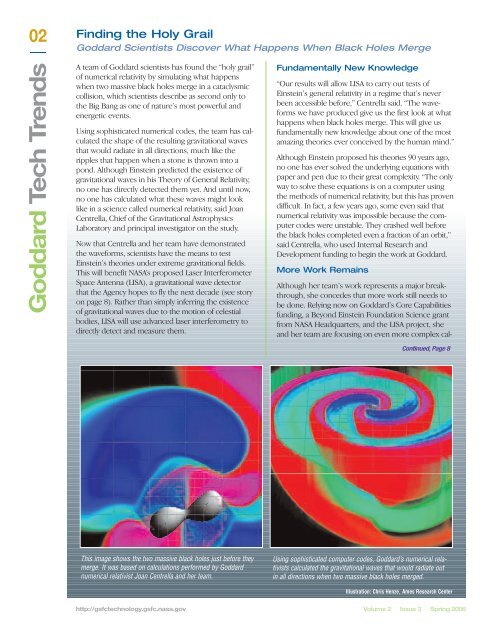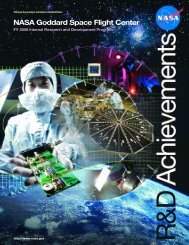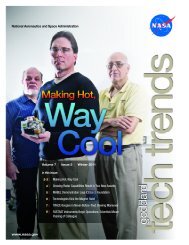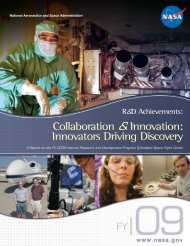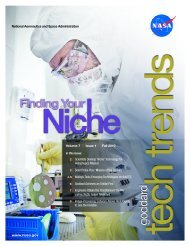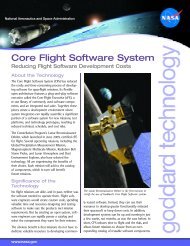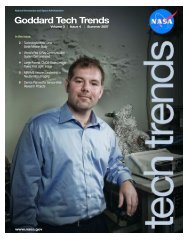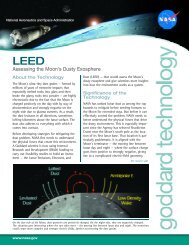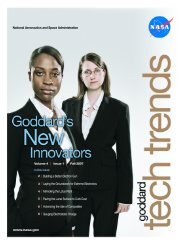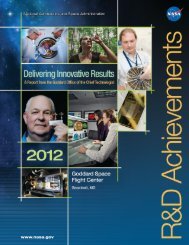Goddard Tech Trends - NASA's Goddard Technology Management ...
Goddard Tech Trends - NASA's Goddard Technology Management ...
Goddard Tech Trends - NASA's Goddard Technology Management ...
Create successful ePaper yourself
Turn your PDF publications into a flip-book with our unique Google optimized e-Paper software.
02<br />
Finding the Holy Grail<br />
<strong>Goddard</strong> Scientists Discover What Happens When Black Holes Merge<br />
<strong>Goddard</strong> <strong>Tech</strong> <strong>Trends</strong><br />
A team of <strong>Goddard</strong> scientists has found the “holy grail”<br />
of numerical relativity by simulating what happens<br />
when two massive black holes merge in a cataclysmic<br />
collision, which scientists describe as second only to<br />
the Big Bang as one of nature’s most powerful and<br />
energetic events.<br />
Using sophisticated numerical codes, the team has calculated<br />
the shape of the resulting gravitational waves<br />
that would radiate in all directions, much like the<br />
ripples that happen when a stone is thrown into a<br />
pond. Although Einstein predicted the existence of<br />
gravitational waves in his Theory of General Relativity,<br />
no one has directly detected them yet. And until now,<br />
no one has calculated what these waves might look<br />
like in a science called numerical relativity, said Joan<br />
Centrella, Chief of the Gravitational Astrophysics<br />
Laboratory and principal investigator on the study.<br />
Now that Centrella and her team have demonstrated<br />
the waveforms, scientists have the means to test<br />
Einstein’s theories under extreme gravitational fields.<br />
This will benefit NASA’s proposed Laser Interferometer<br />
Space Antenna (LISA), a gravitational wave detector<br />
that the Agency hopes to fly the next decade (see story<br />
on page 8). Rather than simply inferring the existence<br />
of gravitational waves due to the motion of celestial<br />
bodies, LISA will use advanced laser interferometry to<br />
directly detect and measure them.<br />
Fundamentally New Knowledge<br />
“Our results will allow LISA to carry out tests of<br />
Einstein’s general relativity in a regime that’s never<br />
been accessible before,” Centrella said. “The waveforms<br />
we have produced give us the first look at what<br />
happens when black holes merge. This will give us<br />
fundamentally new knowledge about one of the most<br />
amazing theories ever conceived by the human mind.”<br />
Although Einstein proposed his theories 90 years ago,<br />
no one has ever solved the underlying equations with<br />
paper and pen due to their great complexity. “The only<br />
way to solve these equations is on a computer using<br />
the methods of numerical relativity, but this has proven<br />
difficult. In fact, a few years ago, some even said that<br />
numerical relativity was impossible because the computer<br />
codes were unstable. They crashed well before<br />
the black holes completed even a fraction of an orbit,”<br />
said Centrella, who used Internal Research and<br />
Development funding to begin the work at <strong>Goddard</strong>.<br />
More Work Remains<br />
Although her team’s work represents a major breakthrough,<br />
she concedes that more work still needs to<br />
be done. Relying now on <strong>Goddard</strong>’s Core Capabilities<br />
funding, a Beyond Einstein Foundation Science grant<br />
from NASA Headquarters, and the LISA project, she<br />
and her team are focusing on even more complex cal-<br />
Continued, Page 8<br />
This image shows the two massive black holes just before they<br />
merge. It was based on calculations performed by <strong>Goddard</strong><br />
numerical relativist Joan Centrella and her team.<br />
Using sophisticated computer codes, <strong>Goddard</strong>’s numerical relativists<br />
calculated the gravitational waves that would radiate out<br />
in all directions when two massive black holes merged.<br />
Illustration: Chris Henze, Ames Research Center<br />
http://gsfctechnology.gsfc.nasa.gov Volume 2 Issue 3 Spring 2006


